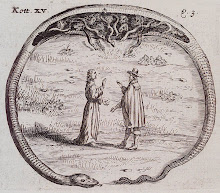


Hullo! I have decided to inaugurate this site with a brief reflection on the surrealist/occultist writer and artist, Ithell Colquhoun (1906-1988).
Distinctively, Ithell Colquhoun’s Goose of Hermogenes reads like a hermetic hybrid of The Wicker Man and Alejandro Jodorowsky’s Holy Mountain. Her two previous books, The Crying of the Wind: Ireland and The Living Stones: Cornwall, both intriguing works of ‘travel writing’ provide some indicators of her interests and concerns as a writer and an artist, which she explored to delirious effect with Goose of Hermogenes. Using her travels as a departure point, she places emphasis on the retelling of the folklore and mythology of particularly mystical areas. Her explorations also focus on the shifting relationships between the natural and the more elusive, spectral worlds. Scenes of great natural beauty are evoked and at the same time, the mystical and occult atmosphere is keenly captured. Indeed, at times, one is reminded of the paintings of mystical scenes by the great symbolist artist, Arnold Böcklin.
However, the defining feature to her writings is her deeply felt belief in the occult and the supernatural. Colquhoun speaks of the fantastical like it is ordinary and commonplace, simply part of the fabric of the everyday. From this position she commands a certain authority, as it is apparent from her life that she truly immersed herself into occult literature and practice. Colquhoun’s world is one definitely attuned to the ether, to the arcane realm of spirits and phantasmagoria. Therefore, it can be argued that her interests are not intended to serve as a mere literary device, rather they represent a matter-of-fact acceptance of the co-habitation of our world by the other, and it is this realisation of her scholarly pedigree, as well as her artistic preoccupations, that ultimately makes Goose of Hermogenes all the more extraordinarily and disarmingly strange.
It truly is a fantastic concoction: the combination of obscure medieval occult references with highly lucid automatic writing techniques. Moreover, at times the reader is in the dark as to whether Colquhoun is describing a stream-of-consciousness piece of surrealist abstraction or incanting a nefarious spell of sorts. Again, like in the travel works, there is a certain visionary and dream-like trance quality to her prose that only adds to the overall sensation of disquiet.
A second effect of this alchemical marriage between magick and surrealism is that when the book really takes flight it can be utterly baffling and cryptic, albeit in quite a spectacular way. Again there is a certain appeal in this- I like to think that Colquhoun has concealed many incredible occultist secrets and images into the text which could be revealed through a lifetime of scholarly robe wearing. Alternatively, it’s just wild nonsense. Either way it will linger in the mind like an old dolmen in a field, collecting multiple interpretations like moss.


Craig, awesome that you started the blog. I'll link to you right away.
ReplyDeleteThanks. You're probably the first visitor! Let's see how disciplined I'll be aboot updating it.....:)
ReplyDeleteHi,
ReplyDeleteLove the blog. Can you please tell me who or what that B&W picture is that is in the background of your blog (underneith the title)?
Thanks